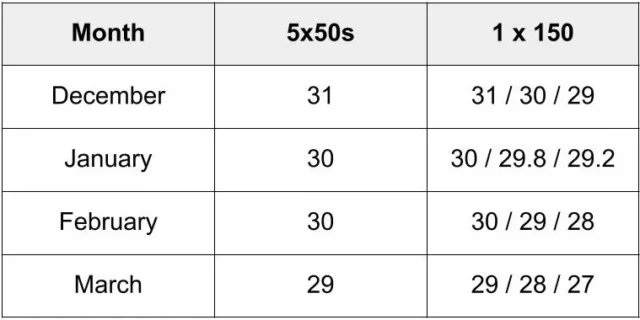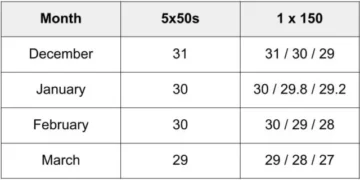Courtesy: Doug Cornish, the founder of Swimpler. Follow Swimpler on Substack here.
A majority of the feedback from Volume 1 consisted of requests for actionable items for coaches who want to apply this with their swimmers. Volume 2 offers some norm-challenging ideas and options that I’ve developed. Swimmers are a varied bunch. So are coaches. The strength of the coaching community is its diversity. By no means am I suggesting that everyone blindly follow along. I’m injecting some data and perspective into a conversation that should continue pushing the envelope of the event. We don’t make progress without thinking outside of the box, trying new things.
Click HERE for Volume 1.
Click HERE for the NCAA D1 200 FR A-Final 2015-2025 Data Set
Both are referenced heavily.
THE PROBLEM WITH PACING
Pacing suggests predictability using repeatable effort to achieve repeatable results. But the 200 free doesn’t work like that. Each 50 is its own beast, differentiated by energy systems, physiological demands, and the ways that each 50 is started and finished.
- 1st 50: Block start to foot-touch. A hybrid of ATP-PCr and early anaerobic energy.
- 2nd 50: Foot to foot. Anaerobic dominant.
- 3rd 50: Foot to foot. Transition phase—anaerobic wanes, aerobic ramps up.
- 4th 50: Foot to hand. Primarily aerobic, influenced by endocrine/neural fatigue.
While it’s possible for the 2nd, 3rd, and 4th splits to be the same, you won’t achieve that through traditional pacing.
Given the 4 truths just mentioned, I ask:
“Where does the athlete encounter consecutive 50’s in which consistent effort will yield a consistent split?”
XYZ SYSTEM OF TEACHING/TRAINING RACE STRATEGY
To simplify teaching and training the 200 FR, and to communicate it in a memorable way, I use a model that I call XYZ.
- Y = X + 2
- Z = Y + 1.9
- If X = Best 50 = 24.0, then:
- Y = 1st 50 = 26.0
- Z = 2nd 50 = 27.9
If you go out too fast, you will bonk. If you go out too slow, you will take yourself out of the race. Like the algebraic equation above, the key to solving the 200 FR is learning that first 50. The value of X unlocks the values of Y and Z.
X & Y
Finding X (Max Speed)
- 50 off the block at top speed with a hand finish in individual heats
- Time = X
- Athlete Example: 24.0
Solving For Y (1st 50 Speed)
- Recover fully after Finding X.
- Rehearse 50s off the block to the foot – and with full recovery at X+2
- Time = Y
- Athlete Example: 24.0 + 2 = 26.0
Being able to hit XY in combination teaches the swimmer the perceived effort and feel necessary to hit the perfect 1st 50. Avoid doing X and Y on different days. This risks disconnecting perceived effort from performance. Since we want them to learn how it feels to go out, the perceived effort needs to become consistent and repeatable.
The second step in mastering the 200 FR is to master the second 50.
Solving for Z = 2nd 50 Speed
- 3 x 50’s @ Y + (1.7 to 1.9)
- Athlete Example: 24.0 + 2 + 1.9 = 27.9
- Level 1 = on 15 seconds rest
- Level 2 = on 10 seconds rest
- Level 3 = on 5 seconds rest
- Advance only when the swimmer consistently holds Z. Avoid moving up the first time they hold Z. Let them master it first.
The 3rd step is to master the 3rd and 4th 50.
These are the most brutal parts of the race. Even the most well-trained, elite athletes struggle to hold their splits here despite going out around two seconds slower than their best 50. Normalize this with your swimmers. Help them understand that the fade is not failure. It’s physiology, and it’s manageable with intelligent race design and training.
Why is it so hard?
- The anaerobic system is failing.
- The aerobic system is ramping up—but it’s not fully in charge yet.
- Acidosis is building.
- Neural fatigue sets in.
- Negative thoughts creep in, triggering energy-draining neurotransmitters like cortisol, reducing motor unit recruitment.
- Muscles are stiff and flooded.
If strategy and effort don’t evolve during this phase, the splits will rise.
That’s why these 50s must be trained deliberately. You can’t just repeat the first half’s strategy—you need to teach swimmers how to shift gears and maintain aggression as systems change. This means simulating the fatigue, the tempo, and the emotion of the back half.
It means building their ability to hold Z under duress.
RACE MODELING
Below is my favorite way to set up the 200 FR after going through XYZ. I’m sharing it because I believe in the creative problem-solving ability of coaches. Feel free to copy if you would like. What I’m really interested in, though, is hearing the ways that you take this information and apply it for the benefit of your swimmers.
200 FR RACE MODEL
5 x 50 FR
- Interval should be about 5 second rest
- Reps should be easily repeatable, fully aerobic, smooth and yield consistent splits
Rest :15
1 x 150 FR
- Descend each 50 starting with the pace from the 5 x 50’s.
- Learning to descend the 50’s within the 150 is the key. Like the 200 FR, it’s not easy.
- Keep repping it, they will get it.
- As swimmers improve, the aerobic pace of the 50’s will slowly improve, which will re-establish the base of their 150.
- The swimmer is “ready” when they hit Z on the 3rd 50 of the 150.
WHY IT WORKS
Not all freestyle technique is the same. Too much aerobic work will pull a swimmer’s stroke toward catch-up, disconnecting the body rotation from the pull. The 5x50s give athletes a chance to fine-tune race-specific technique, while they’re fresh enough to focus, but taxed enough to simulate early-race conditions.
The 1×150 is where the magic happens. Across those 150 yards, the athlete’s heart rate, tempo, and aggression patterns mirror race demands, taking them through all five energy system phases of the 200 FR in real time. Plus, you now have a tangible benchmark: the 3rd 50 split becomes your target, directly comparable to race performance and vice-versa.
That’s what separates a true race model from just another set. It teaches swimmers how to swim the race while conditioning them specifically for it. Frequency, intensity, and duration are aligned with the actual event, targeting the exact systems, strategies, and sensations in the same patterns and along the same timeline as the actual event.
BEWARE OF BROKEN SWIMS
Broken swims feel fast, but they’re not race models. Rest between segments lets swimmers tap energy stores that won’t be available to them mid-race. It’s not the same physiology, not the same demands. Value exists in broken swims, but there is a better way to target race preparation and projection.
REAL LIFE EXAMPLE
I had a girl who was 1:53 in the 200 FR mid-season, at which point we began utilizing the race model above. At champs, she went 1:48. Below is how she advanced within the set over four months to bring about the 1:48.

When she finally hit 27 on the 150, something changed in her. She transformed from fearful to fearless. She went from doubting that she could ever break 1:50 to knowing without a doubt that we were going to see a 27 on the clock for the 3rd 50.
Why? She knew she was capable AND she knew how to do it.
Game-changer!
PUTTING IT ALL TOGETHER
If the only time your swimmer swims a whole 200 FR at race intensity is at the meet, then the race is the only time they are truly preparing for the race itself.
- Teach them how to put the first 50 in the pool by solving for Y
- Teach them how to put the second 50 in the pool by solving for Z
- Teach them how to build speed up to and hold Z through race modeling.
- Give them opportunities to rep the whole 200 at practice at race pace.
We’ve covered steps 1, 2, and 3. Now it’s time for step 4:
Give your swimmers the chance to rehearse the race itself. Not just pace, but full execution, with strategy, focus, and feedback. Take splits. Review. Try again. Rehearsal is practice.
One simple way to do this: treat a practice like a meet. Run heats. Assign teammates to take and record splits. When they finish, they review their data, warm down, hydrate, help a teammate, and get ready to apply what they’ve learned on the next rep.
This isn’t just an opportunity to rehearse the 200 free. It’s an opportunity to rehearse everything: how to warm up, how to cool down, what to eat, when to drink, how to prepare, how to respond. They’re learning how to show up on race day.
No, you won’t rack up a ton of yardage.
But you’ll build better, more informed and more prepared swimmers.
As you work with your swimmers, I’d love to hear about the instruments you’ve created to teach them how to crush the 200 FR.
In my next submission, I’m going to tackle the Sub-1:30 group and dive into Luke Hobson’s 7 x sub-1:30 swims.














